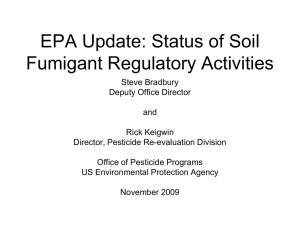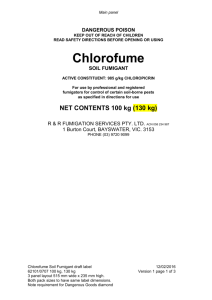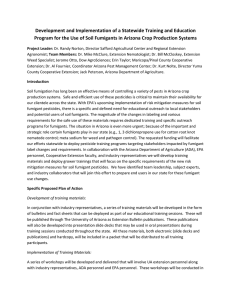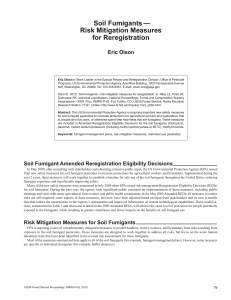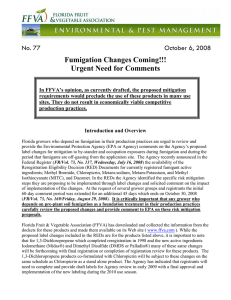Introductions and Welcome U.S. EPA Soil Fumigant Training April 1, 2010
advertisement
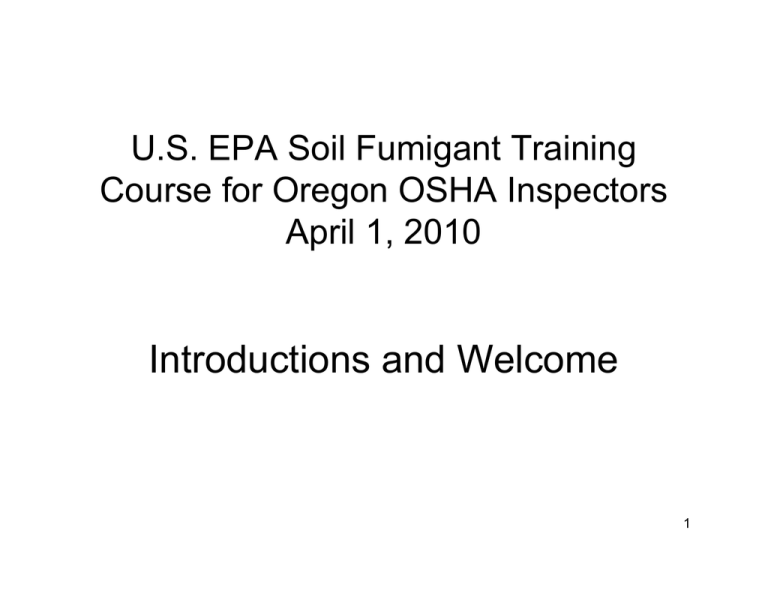
U.S. EPA Soil Fumigant Training Course for Oregon OSHA Inspectors April 1, 2010 Introductions and Welcome 1 Overview - Presentation Outline • • • • • • • Overview of Soil Fumigant Reregistration Implementation Schedule Summary of Label Requirements Summary of Handler Protection Measures Summary of Registrant Requirements Brief Summary of 2011 Measures Next Steps 2 Overview - Key Points • Amended REDs issued June 2009 • Include measures to mitigate risks from fumigant pesticides • Measures will be implemented through product labels • Revised labels with new measures will appear in the field in 2010 and 2011. 3 Overview – Reregistration Eligibility Decisions “REDs” • Re-licensing decisions for chemicals used as soil fumigants – Methyl Bromide – Chloropicrin – Metam Sodium/Metam Potassium – Dazomet • First comprehensive reevaluation since products first registered 4 Overview - Goals • Protect workers and bystanders while maintaining key benefits of use • Ensure a level playing field across all soil fumigants • Risk management decisions that are protective and reflect real-world outcomes 5 Overview - Regulatory Process Timeline 2004: 2006: Public participation process begins Public Comment on Risk Assessments 2005: Draft Risk Assessments Published for Comment, Public Meeting 2007: Public Comment on Mitigation, Public Meetings Held 2008: 2010 Label REDs Changes in Effect Issued 2009: 2011: RED Amendments Issued All mitigation Measures on Labels 6 Overview of Soil Fumigant Uses 7 Types of Pests Controlled 8 Soil Fumigant Use By Crop Crop Chloropicrin Metam Sodium Metam Potassium Methyl Bromide Pounds PCT Pounds PCT Potatoes 300,000 2 32,500,000 20 Strawberries 3,500,000 60 200,000 2 4,400,000 Tomatoes 1,400,000 10 3,100,000 10 3,700,000 7,400,000 50 Carrots Pounds 60,000 1,3Dichloropropene Pounds PCT Total Pounds 12,700,000 10 45,500,000 50 500,000 5 8,600,000 10 200,000 <1 8,600,000 1,100,000 10 8,500,000 4,800,000 20 6,460,000 1,400,000 5 5,100,000 PCT Tobacco 1,600,000 20 Onions 300,000 5 3,400,000 15 Peppers 1,100,000 20 1,900,000 15 1,300,000 15 600,000 10 4,900,000 Watermelons 400,000 5 1,600,000 10 700,000 5 600,000 10 3,300,000 Cotton 20,000 <1 60,000 <1 2,900,000 <1 2,980,000 Cucumbers 500,000 5 200,000 2 1,200,000 15 2,200,000 Peanuts 50,000 <1 300,000 <1 1,700,000 5 2,050,000 EPA proprietary data, Average usage 2006 through 2008 300,000 <1 2 9 Metam Sodium Metam 426, Vapam, HL, Busan 1236, Nemason, Metam CLR, Sectagon 42 EPA proprietary data, Average usage 2006 through 2008 10 Metam Potassium Curtin, Metam KLR, K-Pam HL, Raisan K-50, Sectagon K-54 EPA proprietary data, Average usage 2006 through 2008 11 1,3-Dichloropropene 1,3-D, DD-92, Inline, Telone II, Telone, C-17, C-35 EPA proprietary data, Average usage 2006 through 2008 12 Methyl Bromide Bromocoop, Brom-O-Gas, Terr-O-Gas, Tri-con EPA proprietary data, Average usage 2006 through 2008 13 Chloropicrin Telone, C-17, C-35, Bromocoop, Bromo-O-Gas EPA proprietary data, Average usage 2006 through 2008 14 Risk Overview 15 Risk Overview - Focus Is Acute Residential Bystander Risks Wind Wind blows emissions from an application to a receptor of concern (e.g., house or school) 16 Risk Overview - Soil Fumigant Risk Assessments • Hazard Identification and Assessment – Chloropicrin • Eye, nose, throat, and upper respiratory irritation – Methyl Isothiocyanate (MITC) generators (Metam sodium/potassium and Dazomet) • Eye irritation, systemic, and respiratory effects – Methyl Bromide • Odorless and colorless • Developmental and neurological effects • Skin cancer resulting from ozone-depletion 17 Risk Overview - Soil Fumigant Risk Assessments ! Exposure assessments ! Monitoring studies ! Measure concentrations in and around fields and in the breathing zone of handlers that show concentrations that can cause adverse effects ! Modeling ! Predict concentrations under differing weather and field conditions ! Information from exposure incidents ! Effects observed are consistent with the Risk Assessment predictions ! Causes of exposures 18 Risk Overview – Risk Conclusions • Assessments based on best available data and information • Multiple lines of evidence ! Risk to workers and bystanders are of concern 19 Risk Overview - Mitigation Summary Package of measures that work together to • Reduce potential for direct exposure to toxic concentrations • Reduce likelihood of accidents and errors • Foster planning and compliance • Assure appropriate response to exposures that occur 20 Implementation Schedule 2010 & 2011 2010 Mitigation " Good Agricultural Practices (GAPs) " RUP classification " Handler respiratory protection " Tarp perforation and removal restrictions " Reentry restrictions " Fumigant Management Plans (FMPs) " Registrant-provided handler information 2011 Mitigation " Buffers and buffer posting " Emergency preparedness and response " Restrictions near difficult to evacuate sites " Registrant-provided training and community outreach programs 21 Current Implementation Schedule: 2010 Labeling • • • • Outreach Label Submission Label Approvals Labels in Field Ongoing January 2010 Early Spring 2010 Late 2010 22 Planned Implementation Schedule: 2011 Labeling • • • • Outreach Label Submission Label Approvals Labels in Field Ongoing Late 2010 Early 2011 2011 23 New Label Requirements (2010) Restricted Use Product 24 RUP Classification • All products containing methyl bromide, 1,3dichloropropene, and chloropicrin are currently restricted-use pesticides. • Many soil fumigant products containing metam sodium/potassium and dazomet are not currently restricted use pesticides. 25 RUP Classification • The Agency has determined that all of the soil fumigants undergoing reregistration meet the criteria for restricted use. • EPA will reclassify metam sodium/potassium and dazomet as restricted use pesticides. 26 New Label Requirements (2010) Good Agricultural Practices 27 Good Agricultural Practices (GAPs) • Developed by registrants – Based on input from growers • Reviewed by EPA – Based on input from growers • Many GAPs on current labels – Presently as recommendations – GAPs will be mandatory • Compliance with GAPs will be captured on FMP 28 Good Agricultural Practices (GAPs) • EPA believes GAPs: – Reduce the potential for bystander exposure to soil fumigants emissions. – Reduce the potential for handler exposure to soil fumigant emissions. – Reduce the potential for accidents. – Improve the efficacy of soil fumigation. 29 Good Agricultural Practices (GAPs) • Current labels recommend and require some practices to reduce off gassing, improve safety and effectiveness. • Revised labels will include mandatory steps to protect workers, bystanders and improve effectiveness. • GAPs will be captured on FMP. 30 Good Agricultural Practices (GAPs) • GAPs are chemical specific – GAPs & Labels are consistent when possible across all soil fumigants • Examples – Wind speed restrictions – Soil conditions – Soil temperature – Soil moisture 31 GAPs – Product Labeling • “The following GAPs must be followed during all fumigant applications.” • “All measurements and documentation to ensure the mandatory GAPs are achieved must be recorded in the FMP and/or the postapplication summary report.” 32 GAPs – Soil Temperature • Ground Rig with Soil Incorporation: – “At beginning of application, maximum soil temperature at injection depth is 90°F.” • Chemigation: – “At beginning of application, the maximum soil temp is 90 degrees, measured at 3 inches in depth.” 33 Fumigant Handler Protection Measures (2010) 34 Who is a handler? • A person: – in the application block from the start of the application until the entry restricted period ends, and/or – in the buffer zone from the start of the application until the buffer zone period ends AND • A person performing “handler activities” 35 Handler activities include: • Participating in the application as supervisors, loaders, drivers, tractor co-pilots, shovelers, cross ditchers, or as other direct application participants; • Using devices to take air samples to monitor fumigant air concentrations; • Cleaning up fumigant spills (this does not include emergency personnel not associated with the fumigation application); • Handling or disposing of fumigant containers; • Cleaning, handling, adjusting, or repairing the parts of fumigation equipment that may contain fumigant residues; • Installing, repairing, operating, or removing irrigation equipment in the application block or surrounding buffer zone during the buffer zone period; • Entering the application block or surrounding buffer zone during the buffer zone period to perform scouting, crop advising, or monitoring tasks; • Installing, perforating, removing, repairing, or monitoring tarps • Performing any handling tasks as defined by the WPS. 36 Handler Respiratory Protection • Handlers must stop work or use respirators if air concentrations exceed acceptable limits or if they experience sensory irritation • For methyl bromide formulations with < 20% chloropicrin, handlers must use respirators and monitor with devices to determine the air concentrations to ensure the upper working limit of the respirator is not exceeded. 37 Handlers who use respirators must be: • fit-tested • trained • physically fit to wear a respirator 38 On-site Respirator Availability Fumigant Min # of Handlers On-site 2 Min # of Air Purifying Respirators 2 Min # of Air Rescue Devices 1 Chloropicrin 2 2 1 Metam sodium/ potassium Dazomet 1 1 0 1 1 0 Methyl bromide 39 Tarp Perforation and Removal (2010) 40 Tarp Perforation and Removal Perforation • 5 days after fumigant application is complete Removal • 2 hours after perforation is complete Planting • Less than 14 days after application: – Plant 48 hours after tarp perforation is complete • 14 days or more after application: – Perforate and plant simultaneously 41 Early Tarp Removal and Perforation Exceptions • Early removal (before 5 days) for broadcast applications allowed – if adverse weather conditions (e.g., high wind, hail, storms) have compromised the integrity of the tarp and the tarp poses a safety hazard • Early perforation (before 5 days) for flood prevention activities – Tarps must be retucked and packed after soil removal 42 Entry Restricted Period (2010) 43 Entry Restriction Period • Current labels allow reentry after 48 hours • Fumigant dissipation rate highly variable (soil conditions, application method, tarp type, etc.) • Reentry time lengthened Entry Restricted Period ! REI 44 Entry Restricted Period: Untarped Applications 5 days Drip Shank Untarped Center Pivot 45 Entry Restricted Period: Tarped Applications – For broadcast fumigation: • If tarps are perforated and removed less than 14 days after application – entry into the treated area is prohibited until tarps are removed – For bedded fumigation: • If tarps will not be removed for at least 14 days but they will be perforated – entry into the treated areas is prohibited until 48 hours after tarps are perforated. – For either bedded or broadcast fumigation: • If tarps are perforated and/or removed after 14 days – entry into the treated area is prohibited for 5 days (Note: If people are manipulating tarps within 14 days after application, they are handlers) 46 Fumigant Management Plans (2010) 47 Fumigant Management Plans (FMPs) Implementation FMPs will be implemented in 2 phases: • 2010 - FMPs capture only current and first phase label requirements • 2011 - FMPs will also capture second phase requirements 48 Fumigant Management Plans (FMPs) • Fumigant users must prepare a written, site-specific plan before fumigation begins • FMPs help – Ensure fumigators successfully plan all aspects of a safe and effective fumigation – Prevent accidents, ensure label compliance, and identify appropriate procedures in case of accidents or unforeseen events – Demonstrate compliance with label requirements and are a tool for verifying compliance. 49 Major Elements of FMPs First Phase - 2010 • • • • • • • • • General site and applicator information Application procedures Measurements taken to verify compliance with GAPs Handler protection information Air monitoring and hazard communication procedures Posting (treated area) and record-keeping procedures Emergency plans and procedures Handler training information provided Post-application summary report 50 Post Application Summary • Documents any deviations from the FMP – E.g., date of application, procedures, personnel, etc. • Summary of weather, site conditions • Description of problems or complaints • Actual dates of tarp activities, sign removal, etc. • Completed within 30 days of the application; keep with FMP 51 Fumigant Management Plans (FMPs) Availability FMP must be available: • For viewing on site by handlers involved in the application • To enforcement personnel, upon request • To emergency response personnel, in case of an emergency 52 Fumigant Management Plans (FMPs) Record Keeping • FMPs and Post-Application Summaries must be kept for 2 years by – The certified applicator and – The owner/operator (if not the certified applicator) • Along with other records required for application of RUPs 53 FMP Sample Template 54 Figure 1. Example of Introductory Screen 55 Registrant Requirements (2010 & 2011) Safe Handling Information for Handlers Information for First Responders Training for Certified Applicators Information for Communities 56 Safe Handling Information for Handlers (2010) • Registrants must develop and disseminate basic safety information for handlers – Increase fumigant handlers’ safety awareness • Must include information on – – – – Safe handling practices Respiratory protection Early signs of exposure What to do in case of exposure or emergency • Certified applicators must ensure handlers have received the information within the last year 57 Information for First Responders (2011) • Registrants provide first responders in highfumigant use areas with information to help ensure appropriate responses to incidents to which they may respond • Information includes – How to recognize fumigant exposure incidents – How to treat exposures – How fumigant exposure differs from other types of chemical exposures – Material safety data sheets for fumigants • In development 2010; implemented 2011 58 Training for Certified Applicators (2011) • Registrants must develop and disseminate training for certified applicators in charge of fumigations – Increase knowledge and skill • Must include information on – How to apply correctly – How to protect workers and others – How to comply with new label requirements 59 Information for Communities (2011) Registrants will develop and programs to provide information to communities where use is high " Programs will include information on: 1. What soil fumigants are and how they work 2. What buffer zones are meaning of posted signs 3. Early signs and symptoms of exposure 4. Appropriate steps to take to mitigate exposures 5. What to do in case of an emergency 6. How to report an incident 7. What buffer zone warning signs mean 8. Means to evaluate effectiveness of programs " EPA encourages registrants to work with existing community resources to implement programs " 60 2011 Measures 61 Buffer Zones - (2011) " The area around the application block or greenhouse where bystanders must be excluded during the buffer zone period, except for people in transit. " The “buffer zone period” starts when a fumigant is first delivered to the soil and is in effect for 48 hours after the fumigant has stopped being delivered to the soil. 62 Buffer Zones - (2011) Example Buffer Table Based On New Data Metam Sodium Buffer Table Distance in Feet Rotary Tiller and Spray Blade Applications Block Size In Acres Application Rate (pounds of active ingredient per Acre) 280 300 320 5 25 ft 25 ft 25 ft 7 32 ft 36 ft 39 ft 9 39 ft 47 ft 53 ft 63 Buffer Zone Posting – (2011) 64 Buffer Zone Posting – (2011) " Buffer zones must be posted at usual points of entry and along likely routes of approach to the buffer unless a physical barrier such as a fence prevents access to the buffer " Examples of points of entry include roads, sidewalks, walking paths, and bike trails " Examples of routes of approach include the area between a buffer and a road or a residential area 65 Buffer zone sign must include: # “Do Not Walk” symbol # "DO NOT ENTER/NO ENTRE," # "[Name of fumigant, name of product] Fumigant BUFFER ZONE” # certified applicator contact information 66 Emergency Preparedness and Response – (2011) 67 Emergency Preparedness and Response If occupied structures are in close proximity to a buffer zone, the certified applicator must choose either "“Fumigant Site Monitoring” or "“Response Information for Neighbors” 68 Example Site Map - Emergency Response Measures •If the buffer zone is 125 feet, then these requirements apply to residences within 100 feet of the buffer zone. •Either the applicator must monitor the area between the plain house and the buffer zone or residents of the plain house must be provided emergency response information. • The location of the crosshatched house would not prompt any action. 69 Difficult to Evacuate Sites – (2011) 70 Difficult To Evacuate Sites – (2011) • If the buffer zone is > 300 feet – Then “Difficult To Evacuate Site” must not be within ¼ mile (1320 feet) of the treated area • If the buffer zone is ! 300 feet – Then “Difficult To Evacuate Site” must not be within 1/8 mile (660 feet) of the treated area The difficult to evacuate site cannot be occupied during the application and, for 36-hours after application. EPA has defined difficult-to-evacuate sites as: schools (preschool-12), state licensed daycare centers, nursing homes, assisted living facilities, hospitals, in-patient clinics, and prisons 71 Next Steps 2010 • Training and outreach, Registrants, EPA, States • Revised labels with 2010 mitigation measures appear in the field • New emissions studies submitted, reviewed • Registrants submit amended labels that include measures for 2011 • EPA reviews labels for 2011 use season 2011 • EPA completes reviews of 2011 labels • Full implementation of label requirements and registrant training and outreach programs 2013 • EPA initiates Registration Review for soil fumigants 72 EPA Soil Fumigant Contacts • General Contact: – John Leahy (703) 305-6703 • Chemical Managers: – Methyl bromide: Susan Bartow (703) 603-0065 and Steven Weiss (703) 308-8293 – Metam sodium: Dana Friedman (703) 347-8827 and Dirk Helder (208) 378-5749 – Dazomet: Dana Friedman (703) 347-8827 and Cathryn O’Connell (703) 308-0136 – 1,3-D & Chloropicrin: Andrea Carone (703) 308-0122 – Iodomethane Product Manager: Mary Waller (703) 3089354 E-mail: lastname.firstname@epa.gov 73 ADDITIONAL INFORMATION 74 Respirator fit testing, medical qualification, and training “Employers must verify that any handler who uses a respirator is: • Fit-tested and fit-checked using a program that conforms to OSHA’s requirements (see 29 CFR Part 1910.134) • Trained using a program that conforms to OSHA’s requirements (see 29 CFR Part 1910.134) • Examined by a qualified medical practitioner to ensure physical ability to safely wear the style of respirator to be worn. A qualified medical practitioner is a physician or other licensed health care professional who will evaluate the ability of a worker to wear a respirator. The initial evaluation consists of a questionnaire that asks about medical conditions (such as a heart condition) that would be problematic for respirator use. If concerns are identified, then additional evaluations, such as a physical exam, might be necessary. The initial evaluation must be done before respirator use begins. Handlers must be reexamined by a qualified medical practitioner if their health status or respirator style or use-conditions change. Upon request by local/state/federal/tribal enforcement personnel, employers must provide documentation demonstrating how they have complied with these requirements” 75 OSHA Respirator Medical Evaluation Questionnaire http://www.osha.gov/pls/oshaweb/owadisp.show_document?p_table=STANDARDS&p_id=9783 76 Proximity Triggers for Site-Specific Measures Buffer zones of 25 feet do not require any additional action. If the buffer zone is: > 25 feet and " to 100 feet AND there are residences and businesses: 50 feet from the edge of the buffer zone > 100 feet and " 200 feet 100 feet from the edge of the buffer zone > 200 feet and " 300 feet 200 feet from the edge of the buffer zone > 300 feet 300 feet from the edge of the buffer zone Then the applicator must either: monitor the air (Option 1) or provide information to neighbors (Option 2). 77
